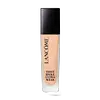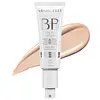What's inside
What's inside
 Key Ingredients
Key Ingredients

 Benefits
Benefits

 Concerns
Concerns

 Ingredients Side-by-side
Ingredients Side-by-side

Water
Skin ConditioningDimethicone
EmollientIsododecane
EmollientAlcohol Denat.
AntimicrobialTrimethylsiloxysilicate
EmollientButylene Glycol
HumectantPEG-10 Dimethicone
Skin ConditioningPerlite
AbsorbentSynthetic Fluorphlogopite
Moringa Oleifera Seed Extract
Skin ConditioningPolymnia Sonchifolia Root Juice
Skin ConditioningCalcium Aluminum Borosilicate
Glycerin
HumectantDipentaerythrityl Tetrahydroxystearate/Tetraisostearate
Skin ConditioningAlpha-Glucan Oligosaccharide
CleansingSodium Hyaluronate
HumectantSilica
AbrasiveSilica Silylate
EmollientHdi/Trimethylol Hexyllactone Crosspolymer
Cellulose
AbsorbentAluminum Hydroxide
EmollientMagnesium Sulfate
Nylon-12
Disodium Phosphate
BufferingDisodium Stearoyl Glutamate
CleansingIsopropyl Lauroyl Sarcosinate
Skin ConditioningHydrogen Dimethicone
Citric Acid
BufferingDiisopropyl Sebacate
EmollientBis-PEG/PPG-14/14 Dimethicone
EmollientLactobacillus
Skin ConditioningMaltodextrin
AbsorbentDisteardimonium Hectorite
StabilisingBHT
AntioxidantTocopherol
AntioxidantPhenoxyethanol
PreservativeTitanium Dioxide
Cosmetic ColorantIron Oxides
Water, Dimethicone, Isododecane, Alcohol Denat., Trimethylsiloxysilicate, Butylene Glycol, PEG-10 Dimethicone, Perlite, Synthetic Fluorphlogopite, Moringa Oleifera Seed Extract, Polymnia Sonchifolia Root Juice, Calcium Aluminum Borosilicate, Glycerin, Dipentaerythrityl Tetrahydroxystearate/Tetraisostearate, Alpha-Glucan Oligosaccharide, Sodium Hyaluronate, Silica, Silica Silylate, Hdi/Trimethylol Hexyllactone Crosspolymer, Cellulose, Aluminum Hydroxide, Magnesium Sulfate, Nylon-12, Disodium Phosphate, Disodium Stearoyl Glutamate, Isopropyl Lauroyl Sarcosinate, Hydrogen Dimethicone, Citric Acid, Diisopropyl Sebacate, Bis-PEG/PPG-14/14 Dimethicone, Lactobacillus, Maltodextrin, Disteardimonium Hectorite, BHT, Tocopherol, Phenoxyethanol, Titanium Dioxide, Iron Oxides
Water
Skin ConditioningCyclopentasiloxane
EmollientOctyldodecanol
EmollientGlycerin
HumectantDimethicone/Vinyl Dimethicone Crosspolymer
Skin ConditioningDimethicone
EmollientCyclohexasiloxane
EmollientPropylene Glycol
HumectantIsopropyl Myristate
EmollientBis-PEG/PPG-14/14 Dimethicone
EmollientMica
Cosmetic ColorantAluminum Starch Octenylsuccinate
AbsorbentHexyl Laurate
EmollientCetyl PEG/PPG-10/1 Dimethicone
EmulsifyingPolyglyceryl-4 Isostearate
EmulsifyingSilica
AbrasiveXylitylglucoside
HumectantDimethicone Crosspolymer
Emulsion StabilisingSodium Chloride
MaskingAnhydroxylitol
HumectantDisteardimonium Hectorite
StabilisingIsododecane
EmollientXylitol
HumectantTrihydroxystearin
Skin ConditioningAcrylates/Dimethicone Copolymer
Skin ConditioningPropylene Carbonate
SolventTocopheryl Acetate
AntioxidantHydrolyzed Hyaluronic Acid
HumectantButylene Glycol
HumectantTriethoxycaprylylsilane
Camellia Oleifera Leaf Extract
AstringentLauroyl Lysine
Skin ConditioningAloe Barbadensis Leaf Juice
Skin ConditioningChlorphenesin
AntimicrobialIsoceteth-10
EmulsifyingGlucose
HumectantMyristic Acid
CleansingCitric Acid
BufferingPotassium Sorbate
PreservativePhenoxyethanol
PreservativeSodium Benzoate
MaskingCI 77891
Cosmetic ColorantCI 77492
Cosmetic ColorantCI 77491
Cosmetic ColorantCI 77499
Cosmetic ColorantWater, Cyclopentasiloxane, Octyldodecanol, Glycerin, Dimethicone/Vinyl Dimethicone Crosspolymer, Dimethicone, Cyclohexasiloxane, Propylene Glycol, Isopropyl Myristate, Bis-PEG/PPG-14/14 Dimethicone, Mica, Aluminum Starch Octenylsuccinate, Hexyl Laurate, Cetyl PEG/PPG-10/1 Dimethicone, Polyglyceryl-4 Isostearate, Silica, Xylitylglucoside, Dimethicone Crosspolymer, Sodium Chloride, Anhydroxylitol, Disteardimonium Hectorite, Isododecane, Xylitol, Trihydroxystearin, Acrylates/Dimethicone Copolymer, Propylene Carbonate, Tocopheryl Acetate, Hydrolyzed Hyaluronic Acid, Butylene Glycol, Triethoxycaprylylsilane, Camellia Oleifera Leaf Extract, Lauroyl Lysine, Aloe Barbadensis Leaf Juice, Chlorphenesin, Isoceteth-10, Glucose, Myristic Acid, Citric Acid, Potassium Sorbate, Phenoxyethanol, Sodium Benzoate, CI 77891, CI 77492, CI 77491, CI 77499
 Reviews
Reviews

Ingredients Explained
These ingredients are found in both products.
Ingredients higher up in an ingredient list are typically present in a larger amount.
Bis-PEG/PPG-14/14 Dimethicone is a type of silicone.
Butylene Glycol (or BG) is used within cosmetic products for a few different reasons:
Overall, Butylene Glycol is a safe and well-rounded ingredient that works well with other ingredients.
Though this ingredient works well with most skin types, some people with sensitive skin may experience a reaction such as allergic rashes, closed comedones, or itchiness.
Learn more about Butylene GlycolCitric Acid is an alpha hydroxy acid (AHA) naturally found in citrus fruits like oranges, lemons, and limes.
Like other AHAs, citric acid can exfoliate skin by breaking down the bonds that hold dead skin cells together. This helps reveal smoother and brighter skin underneath.
However, this exfoliating effect only happens at high concentrations (20%) which can be hard to find in cosmetic products.
Due to this, citric acid is usually included in small amounts as a pH adjuster. This helps keep products slightly more acidic and compatible with skin's natural pH.
In skincare formulas, citric acid can:
While it can provide some skin benefits, research shows lactic acid and glycolic acid are generally more effective and less irritating exfoliants.
Most citric acid used in skincare today is made by fermenting sugars (usually from molasses). This synthetic version is identical to the natural citrus form but easier to stabilize and use in formulations.
Read more about some other popular AHA's here:
Learn more about Citric AcidDimethicone is a type of synthetic silicone created from natural materials such as quartz.
What it does:
Dimethicone comes in different viscosities:
Depending on the viscosity, dimethicone has different properties.
Ingredients lists don't always show which type is used, so we recommend reaching out to the brand if you have questions about the viscosity.
This ingredient is unlikely to cause irritation because it does not get absorbed into skin. However, people with silicone allergies should be careful about using this ingredient.
Note: Dimethicone may contribute to pilling. This is because it is not oil or water soluble, so pilling may occur when layered with products. When mixed with heavy oils in a formula, the outcome is also quite greasy.
Learn more about DimethiconeDisteardimonium Hectorite comes from the clay mineral named hectorite. It is used to add thickness to a product.
It can also help stabilize a product by helping to disperse other ingredients.
Hectorite is a rare, white clay mineral.
Learn more about Disteardimonium HectoriteGlycerin is already naturally found in your skin. It helps moisturize and protect your skin.
A study from 2016 found glycerin to be more effective as a humectant than AHAs and hyaluronic acid.
As a humectant, it helps the skin stay hydrated by pulling moisture to your skin. The low molecular weight of glycerin allows it to pull moisture into the deeper layers of your skin.
Hydrated skin improves your skin barrier; Your skin barrier helps protect against irritants and bacteria.
Glycerin has also been found to have antimicrobial and antiviral properties. Due to these properties, glycerin is often used in wound and burn treatments.
In cosmetics, glycerin is usually derived from plants such as soybean or palm. However, it can also be sourced from animals, such as tallow or animal fat.
This ingredient is organic, colorless, odorless, and non-toxic.
Glycerin is the name for this ingredient in American English. British English uses Glycerol/Glycerine.
Learn more about GlycerinIsododecane is a fragrance, emollient, and solvent.
As an emollient, it helps your skin stay soft and hydrated. Emollients help trap moisture into your skin.
Isododecane's role as a solvent makes it a great texture enhancer. It spreads smoothly on skin and does not leave a sticky feeling behind. Isododecane also helps prevent color transfer in makeup products.
Isododecane is not absorbed into skin.
Learn more about IsododecanePhenoxyethanol is a preservative that has germicide, antimicrobial, and aromatic properties. Studies show that phenoxyethanol can prevent microbial growth. By itself, it has a scent that is similar to that of a rose.
It's often used in formulations along with Caprylyl Glycol to preserve the shelf life of products.
Silica, also known as silicon dioxide, is a naturally occurring mineral. It is used as a fine, spherical, and porous powder in cosmetics.
Though it has exfoliant properties, the function of silica varies depending on the product.
The unique structure of silica enhances the spreadability and adds smoothness, making it a great texture enhancer.
It is also used as an active carrier, emulsifier, and mattifier due to its ability to absorb excess oil.
In some products, tiny microneedles called spicules are made from silica or hydrolyzed sponge. When you rub them in, they lightly polish away dead skin layers and enhance the penetration of active ingredients.
Learn more about SilicaWater. It's the most common cosmetic ingredient of all. You'll usually see it at the top of ingredient lists, meaning that it makes up the largest part of the product.
So why is it so popular? Water most often acts as a solvent - this means that it helps dissolve other ingredients into the formulation.
You'll also recognize water as that liquid we all need to stay alive. If you see this, drink a glass of water. Stay hydrated!
Learn more about Water